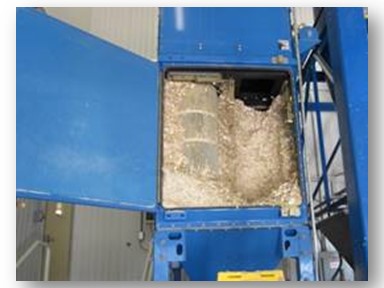Baghouses and cartridge collectors are usually designed to handle a maximum of 6” W.C. of pressure drop. When the baghouse pressure drop is 6” W.C., the airflow through the system is enough for proper operation. When the pressure drop across the bags is greater than 6” W.C., the airflow through the system is less than it should be. The baghouse uses a control system to keep the pressure drop through the system to less than 6” W.C. Most baghouses use compressed air to clean the bags, but shaking and sonic cleaners are also used.
The two main controllers used are timers and clean on demand. A timer is a simple controller which will turn on the cleaning cycle at a set time, such as every 5 minutes. The timer can be changed, and a manual clean is usually available. While the initial cost of this timer is less, it can end up wasting a lot of money if the timer is cleaning more often than required. If the timer isn’t cleaning enough, then the dust collector is not operating at its optimal flow. The other controller option is clean on demand. This controller uses a differential pressure transmitter to monitor the pressure drop across the bag. When the pressure drop gets to a certain point, it will begin cleaning the bags until the pressure drop is lowered to an acceptable point. This can save you a lot of money by minimizing the compressed air required. However, if your bags are plugged, the cleaning can be continuous as the pressure drop will never fall below the cutoff point.
Filters will have high-pressure drops due to a variety of separate reasons or even a combination of reasons working together. These include heavy dust loading, wet or humid conditions, worn diffusers, humid compressed air, improper cleaning, and old filters.
- Heavy dust loading will plug filters faster than lower dust loadings. The faster dust covers the filters, the more the cleaning is required. However, every cleaning doesn’t get 100% removal so over time the dust layer will get thicker and thicker; thereby, increasing the pressure drop.
- Wet or humid dust are conditions that can cause premature plugging. When the dust gets wet, it can form a mud. This could prevent air from passing through, thereby increasing the pressure drop. If the dust is hygroscopic and/or if the filter is pleated, the filter can plug up even faster.
- Dirty air entering a baghouse usually goes through a diverter, which directs the air evenly to each bag. Many times the diverter is some metal shape. Over time, abrasive dust will wear away the diffuser, changing the airflow. In this case, some filters will get heavier dust loadings than others. The filters getting the heavier dust loading will then plug faster, increasing the pressure drop through the system.
- Humid compressed air can cause major issues with certain dusts. If the dust is hygroscopic, then adding moisture to the system can cause problems. Some dust becomes a mud while others form a concrete-like substance. Since the humidity is coming from the cleaning air, the humidity is meeting the dust in the filter holes, thereby plugging them up faster, and making it even harder for them to be cleaned.
- If the cleaning system isn’t operating properly, the bags will not clean effectively. This could be anything from stuck/broken air valves, misaligned venturi, bags stuck on cages or too low compressed air. Since the bags are cleaned by an expansion of the bag and losing the dust layer, if air isn’t delivered correctly, the bag may not fully inflate and not fully clean. So any obstruction or barrier to full inflation would cause premature plugging.
- As mentioned above, over time all filters will plug up.
The best way to keep your dust collector working properly is to have a professional maintenance crew inspect and maintain your dust collectors. Not only does this open your maintenance staff for other work, it allows them to use their experience to keep your baghouse operating at peak performance.
Click here to get a free guide for helping you to evaluate if your current dust collection system is properly and efficiently operating.


